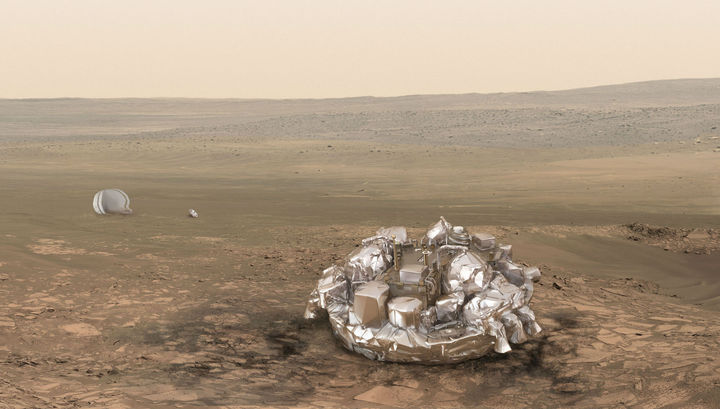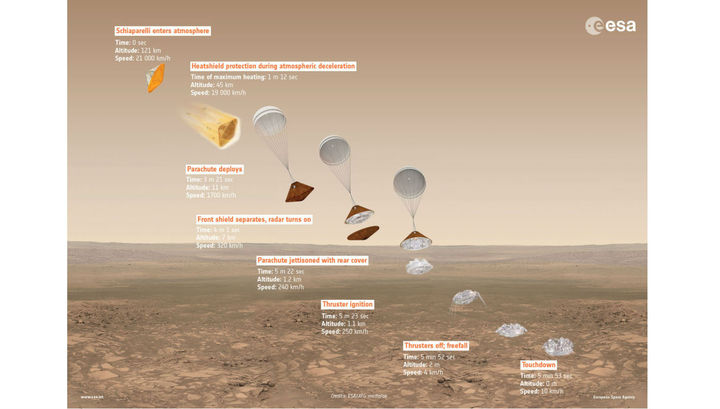the mission control center of the European space Agency in Darmstadt (Germany) are making last adjustments to the program key phase of the mission ExoMars 2016, which is carried out jointly with the Russian state Corporation “Roskosmos”.
Launched on 14 March 2016, the spacecraft ExoMars consists of reconnaissance Orbiter Trace Gas Orbiter (TGO), which will study the atmosphere of the red planet, and a demonstration lander “Schiaparelli” (Schiaparelli).
16 Oct lander “Schiaparelli”, named after the Italian astronomer Giovanni Schiaparelli, must be separated from the TGO and in three days, that is October 19, safely to fall on the surface of the red planet in the Plateau of Meridian.
October 3, the team has developed a probe from hibernation, and October 7 loaded in the onboard computer command sequence to enter the Martian atmosphere and landing, which, according to the plan, to be held on October 19 at 14:48:11 GMT (17:48:11 GMT).

the Unit will enter the atmosphere of the red planet at the speed of 21,000 km/h and he will have just six minutes in order to reset it to a safe level. Then work the chute, the signal for the computer to drop the protective shield of the probe (it will save the device from burning up in the atmosphere). A further reduction will occur on Gerasimovich rocket thrusters, which will shut down at the height of about two meters.
the 600-pound probe “Schiaparelli” was designed to test landing technologies and work in the Martian conditions required for launch in 2020, Mars Rover ExoMars. In addition, the device is equipped with a small amount of scientific equipment needed to conduct observations and transmit data to Earth through the orbital module.
However, unlike the famous Rovers, such as Curiosity, which roam the Martian plateau for several years, the service life of the probe’s small battery will be enough for a few days.
After the descent “Schiaparelli” will conduct measurements of wind speed, humidity, pressure and temperature at the landing site, as well as electric fields and atmospheric dust on the planet’s surface. The researchers hope that these data will help to understand the role of electrical forces in the formation of Martian dust storms.
by the Way, during landing, the probe can expect the warmest of welcomes. Observations show that in the near future on the red planet may start the season, most of those dust storms. A particularly strong storm raging on Mars at a time when summer in the southern hemisphere coincides with the passage through the perihelion – nearest to the Sun point of the orbit. For example, the dust storm that began in September, 1971, has raged for four months and ended in January 1972.
But in the European space Agency claim that climate shocks will not be a surprise to them. On the contrary, the prospect of landing in the clouds of sand has its advantages.
“We knew that the arrival of the probe may coincide with the dust storm and this was taken into account in the development of the “Schiaparelli,” says project scientist Jorge Vago (Vago Jorge). – And from the point of view of collecting data about electrical fields dusty atmosphere it may be very good.”

the Floating particles will increase the load on the heat panels and the parachute the probe, but the developers say that all systems have passed the required tests on the Ground. In addition, the design of the probe allows to minimize the influence of strong wind on the position of the body during descent to the surface.
In the official press release from ESA mission organizers urge everyone to join the broadcast this, of course, significant events in the history of space exploration.
In contrast to the “Schiaparelli” Orbiter will begin its work only at the end of 2017. All this time it will be through complicated maneuvers to reach its orbit. The objectives of TGO includes creating a detailed list of atmospheric gases on Mars.
of Most interest to researchers will be to introduce methane as evidence of the possible existence of past or present life. Among other things, the probe will have to determine the geographical and seasonal variability of methane content in atmosphere of the red planet to finally try to understand its origins are geological or biological.
No comments:
Post a Comment